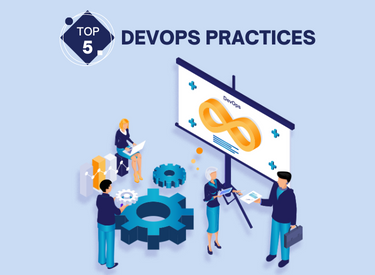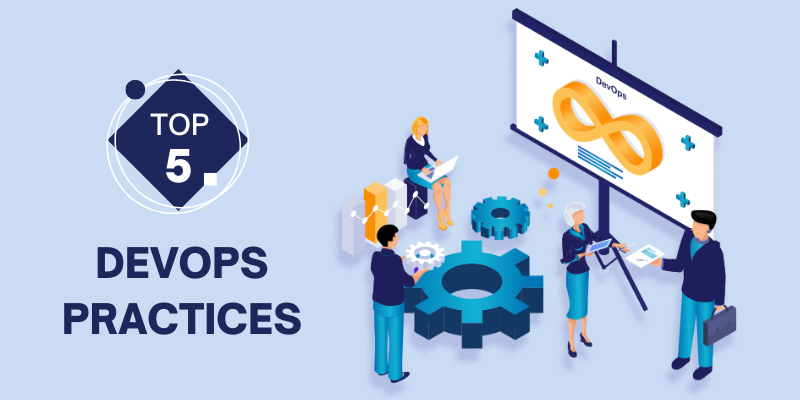Top 5 DevOps Best Practices You Should Use

DevOps is becoming increasingly relevant in many technological businesses due to two contradictory aims and cultures that must coexist:
- Agile development teams work quickly to meet business requirements and implement application change.
- The operational teams work hard to maintain systems’ performance, secure computing environments and manage computing resources.
Many agile teams view operational teams as rigid and slow, while system engineers see agile developers as inflexible and unsupportive of functional requirements.
Although these are generalizations, the two disciplines often have different motivations, terminology and tools. This can lead to business problems. As startups grow, it is necessary to create operational procedures that ensure stability and minimize the impact on their development speed. Large enterprises must find faster ways to deliver customer-facing apps and improve internal workflow without compromising reliability or falling foul of compliance.
DevOps seeks to resolve these conflicts by creating a culture, operating principles, and emerging best practices that allow for speedy deployment and stability while running applications with fewer compromises and conflicts. It is done by standardizing configurations and automating operational steps.
- These practices are designed to standardize and automate the steps taken by development teams, from creating code to testing, securing and running applications in multiple environments.
- The practices automate operations such as configuring and deploying infrastructure and monitoring across multiple domains. This allows for faster resolution of production problems.
These are some of the DevOps practices:
- Version control and branching strategies
- Continuous integration and continuous delivery ( CI/CD) pipelines.
- Containers that isolate and standardize application runtime environments.
- Infrastructure as code (IaC) allows scripting of the infrastructure layer.
- Monitoring the health of running apps and the DevOps pipelines.
Agile development practices for release management
The practices and tools for releasing software into computing environments are the foundation of DevOps. These fundamentals have been around for decades. These include version control to manage code change across a team of programmers, branching the code base in support of different development activities, and version tagging software releases before they are pushed into other environments.
DevOps teams will notice that these tools are simpler to use and can be integrated with other technologies that automate the building and deployment of applications. Modern version control systems are more flexible and allow easier code merging and branching.
Many organizations use Git, including GitHub, BitBucket version, and other version control tools. These tools offer multiple client applications, APIs to integrate, and command-line tools for managing more complex or frequent procedures. Most developers use at least one version control technology for their projects today. This makes it easier to implement standards.
These tools allow organizations to adopt branching strategies such as Gitflow, which standardize branches for development, testing, production, and development. They also establish procedures for the development of new features and production patches. Branching strategies allow teams to collaborate on different types and product types and only introduce code that deploys into production branches. Teams use version tagging to identify all versions of source code or other files included in a software release.
Read more: DevOps and Agile: How to Agile & DevOps Interrelated
Automated release management and continuous integration with deployment
Most businesses that require user assistance after production releases and those still in the early stages of creating their DevOps practices adhere to traditional release-management approaches that support concepts such as major and minor releases. When automation continually integrates and delivers code changes to production settings, more advanced teams designing apps that require less user support can perform the continuous deployment. This can be achieved when automation continuously integrates and delivers changes to production environments.
Teams look for automated ways to deliver thoroughly tested applications to their target computing environments. This will enable them to release more often. Continuous integration (CI) is the automation of building and integrating all software components into a deployable package. Continuous deployment (CD) tools automate the pushing of applications to development, testing, production and other computing environments. These tools make up the CI/CD pipelines.
Continuous testing must be done for CI/CD process to work efficiently. This will ensure that the new code doesn’t introduce defects or other issues. Continuous integration pipeline unit tests ensure that code isn’t breaking existing unit tests. Integration can also include tests to check for code-level security and code structure. Continuous delivery pipelines often automate automated functional and performance tests dependent on runtime environments.
Automation drives positive behavioral and practice changes, which enable teams to make more frequent and safer changes. Besides, automation allows teams to test and check code more often, making it easier for defects to be identified and fixed faster, greatly reducing the risk of errors in manual deployment procedures. The automation also takes most of the overhead in pushing new capabilities to users, and allows teams to deploy more often.
Read more: Top 30 Most Effective DevOps Tools for 2022
Containers to drive microservices
Containers are the packaging for the application’s operating system if CI/CD is used to automate the delivery of applications. Developers can specify the operating system, application requirements and configuration requirements to create a container that runs the applications on an isolated layer. It shares the operating system with its host. Kubernetes and Docker are container technologies that allow developers to define consistent application environments.
Developers can create application services with CI/CD pipelines that integrate and deploy code. They also have standardized containers that isolate the computing needs of each application. Developers have more options to translate business requirements into Microservices that are easily scaled and used for multiple business purposes.
Read more: Top 10 Essential Skills for DevOps Engineer
Automating configuration and provisioning using infrastructure as code (IaC)
Automating code integration, delivery and containerization drive application delivery. The following DevOps practices help to automate the infrastructure and cloud services.
It used to be difficult to automate and manage infrastructure. After a selected architecture was chosen, operational engineers went to different infrastructure components to construct and configure them to meet requirements. These architectures were captured using a combination of manual and automated steps. Computer environments were also very rigid. While there were tools that could automate scaling settings, these tools were usually limited to specific infrastructure types, required different skills and only had access to a small amount of operational data to decide whether or not to scale.
Cloud environments offer user interfaces that make it easier for engineers to work in them. These tools allow engineers to create virtual private networks, configure security groups, and launch compute, storage and other services.
DevOps teams go one step further. They automate the entire process using code instead of manually configuring computing resources through the web interface. Infrastructure code (IaC) tools allow operational engineers to script and automate infrastructure management and setup. These scripts can also include configurations that allow scaling up or down environments. Chef (Puppet), Ansible (Salt) are all competing technologies that can be used to implement IaC.
Read more: 4 Key DevOps Metrics – How To Measure and Improve It
Monitoring the DevOps pipelines and applications
Manufacturing processes are only as good as detecting, alerting, and resolving problems. This is also true for monitoring and the user experience when running applications and services. Parallel investments in monitoring are a good idea as organizations invest in automation, containerizing and standardizing applications.
Consider monitoring at multiple levels. Infrastructure monitoring allows for detecting and responding to computing resources’ problems. Cloud environments can monitor, alert and use elastic cloud capabilities to address infrastructure issues.
Next is the toolset to capture and monitor metrics related to DevOps automation. These tools are more important as developers increase in number and deployment options. These tools alert you when builds fail and provide auditing tools that help to diagnose problems.
Some tools monitor application performance and uptime. These tools are used to test APIs, perform browser tests and run complete browser tests on single or multi-step transactions. These monitors alert developer teams when APIs and applications are not operating at acceptable service levels.
DevOps practices: Where do you start?
Many DevOps practices exist and each takes time to develop and integrate. There are no complex recommendations or a set sequence for implementing them.
Organizations should align their culture and mindset with DevOps principles and identify best practices to meet business needs. Organizations that have poor application performance might choose to start monitoring to identify root causes and help speed up the resolution. Others may opt to deploy infrastructure as code. In contrast, others establishing standard architectures for application development may prefer CI/CD pipelines.
Technologists need to remember that automation comes with a cost. Not every organization needs continuous deployment. It is best to focus on the business and align automation with areas where manual effort is high-risk.
Read more: How to Select a Best DevOps Service Provider

